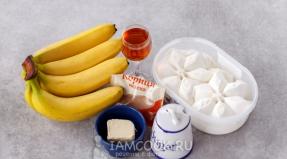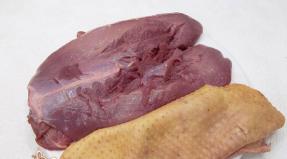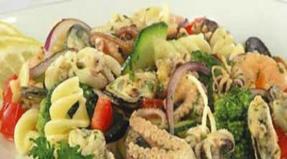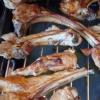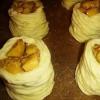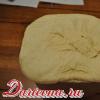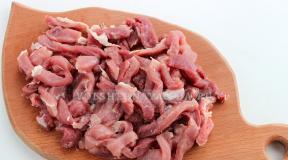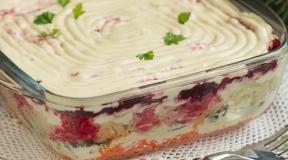Viennese pastry for Easter cakes. Viennese pastry cake
I dug up this recipe in my grandmother's notebook. This is just an amazing treat! It was such a pleasure to work with the test! I admit honestly, I didn’t cook myself, but helped my grandmother, but I managed to feel all the subtleties of working with this test.
The recipe without any problems, really, quickly, and the result is simply excellent!
The portion is very large, so you can safely divide the ingredients by 2.
Ingredients:
- 3 kg. flour
- 100 gr yeast
- 1l milk
- 600gr. margarine (butter)
- 1kg sugar
- 12pcs eggs
- 200 - 300gr. raisins
- vanillin
Cooking:
1. Beat eggs with sugar.
2. Add yeast, milk, margarine (!!! no flour!!!). If there are lumps of margarine, then you can warm this mixture a little, stirring until the lumps disappear. Get a homogeneous mass.
3. Mix all this thoroughly, wrap it up and put it in a warm place for 8-10 hours. (During this time, all this will have to ferment, rise and fall).
4. After 8-10 hours (in the morning), pour 1 teaspoon into this fermented dough. a spoonful of salt without top), vanillin, flour and raisins (preliminary pour over the raisins with boiling water and dry)
5. And start kneading this dough thoroughly until it starts to fall behind your hands. If, nevertheless, the dough sticks to your hands for a long time, you can add a little flour.
6. Lubricate all molds generously with sunflower oil, but better with butter (then the Easter eggs will not stick to the molds).
7. Put the dough in molds about 1/3 of the volume of the mold and put it on the table. get up.
8. When the dough in the molds rises to half the mold, you can put Easter in a preheated oven to a temperature of 200-250 degrees.
9. Depending on the size of the mold, Easter can already be taken out in turn after 30-50 minutes. During this time, they will rise above the edge of the mold, and the top of the Easter will begin to darken.
10. In advance, you can beat 1 protein and 100g. sugar and refrigerate.
11. Take out Easter, and while they are hot - grease them with this protein and immediately sprinkle with colored powder and other Easter decorations)


Today I want to dwell in more detail on baking Easter cake from the "Viennese dough". I have been baking Easter cakes according to this recipe for about 20 years, I certainly try to bake Easter cake according to some new recipe every year, but my relatives require Easter cake from the "Viennese dough".
The beauty of this recipe is that the main dough - sourdough must be made at night, there is no need to follow the dough for half the night, which strives to escape from under your control, we sleep with pleasure and in the morning strong and rested, ready to bake this wonderful, fragrant with moist ( I don't like light and dry Easter cakes!) Festive Easter cake with crumb.
I will make a reservation right away, I bake Easter cakes for two norms (for 2 liters of milk), since I have many relatives and friends, and I have never had a cake. Once I specially left one small Easter cake for a week (I keep chilled Easter cakes in a plastic bag, only the decorated top sticks out of the bag, you will see for yourself if you look at the photo), it remained soft and tasty))
So, I give a recipe for 1 liter of milk:
Ingredients for Easter cake "Vienna"
Milk - 1 l
Yeast (dry) - 1.5 tbsp. l. or pressed - 100 gr
Sugar - 3.5 stack.
Margarine (for baking or creamy) - 250 g
Egg - 8 pcs
Butter - 100 g
Salt - 1 tsp
Cognac - 3-4 tbsp (additionally loosens the dough)
Raisins - 100 - 200 g
Dried apricots - 100 g (makes the crumb in the cake moist)
Candied fruits - 100 g
Flour (about) - 3 kg
Potatoes (boiled) - 200 g (Kulich keeps fresh longer)
Vanillin 2 packets (or essence "Duchess" - 1 tbsp)
Vegetable oil b / smell - 100 - 150 ml (for kneading the dough)
Vegetable oil (odorless, for mold lubrication)
Semolina (for mold powder)
Glaze:
Proteins - 2 pcs.
Powdered sugar - 200 gr
Lemon juice - 2 tbsp
Now more about the preparation of the cake:
At 22 o'clock put the dough:
one). Beat 1 glass of sugar with 2 eggs, add 1.5 tbsp. to 0.5 liters of warm milk. l. dry yeast (100 gr. fresh, I prefer them), combine beaten eggs with milk, grate boiled potatoes, add them to the dough and mix everything thoroughly. Knead the dough in a 3 - 4 liter enamel saucepan, cover with a lid and put in the REFRIGERATOR for 10 hours.
2). Grind 6 yolks thoroughly with salt with a wooden spoon and put in the refrigerator, from this procedure the yolks will become brighter.
3). In the morning (about 8 o'clock) you will see a sizzling mass rising like a hat.
2. Rub 5 cups of sugar thoroughly with 250 gr. melted creamy margarine, add 0.5 liters of warm milk here, 100 gr. melted butter. Mix well and put this mass on a small fire. Constantly stirring, so as not to burn, heat to 50 degrees, remove from heat and pour the fermented brew from the refrigerator, grated yolks from their refrigerator, four whites whipped to a cap, (leave two whites for glaze) mix everything well.
4). Rinse the raisins, dry them and pour boiling water over them, let them stand for 30 minutes, drain the water and dry them on a towel (you can pour 3-4 tablespoons of cognac in the evening and add to the dough with it), cut dried apricots the size of raisins, and we have candied fruits sold ready-made in the same size.
5). First, flour should be added to the prepared mixture (the flour should be well dried and sifted twice to enrich it with oxygen) in small portions so that the dough does not become heavy, when it becomes difficult to mix with a spoon, pour flour on the table and start kneading with your hands.
6). Add raisins, dried apricots and candied fruit to the dough when it is still sticky to your hands, add essence (I take DUSHES) or vanillin (to taste) and knead the dough until it falls behind your hands (it will squeak under your hands), but add a little flour, the dough should be soft and light. If the flour remains, no big deal.
7). Take a 5 - 6 liter enamel pan, grease it with vegetable oil and put the dough there, cover with a towel and put in a warm place for proofing, it should increase 3 times (1.5 -2 hours).
eight). Lubricate the cake molds from the inside with odorless vegetable oil, cut out circles of cardboard along the diameter of the molds at the bottom, also grease and sprinkle the bottom and walls of the molds from the inside with semolina.
9). When the dough has increased to the desired size, pour a little rast onto the table. butter, spread it with your hand on the table, lay out the dough and knead it well (do not add more flour so that the dough does not stick to your hands, moisten them with vegetable oil)
10). I turn on the oven immediately in the morning when I start to close up the dough (so that the kitchen warms up well). Each piece of dough, before being put into a mold, must be rolled into a bun, fill the molds by 1/3, let it rise to 3/4 and put in the oven on the lower shelf (I put a baking sheet with water under it, add it as it evaporates hot water).
eleven). Oven at 180 °C small 20 -25 min, 700 -1000 gr. 40 -50 min, 1 -1.5 kg for about 1.5 hours. First, fill and bake small cakes, then medium and large ones, so that the dough does not fall off and the tops of the cakes do not undermine.
12). CHECK THE READINESS OF PASTRY WITH A WOODEN SPLIT (a dry splinter - the Easter cake is ready).
thirteen). Cool the cake on its side. After 10 minutes, carefully separate the Easter cake in a circle from the walls of the mold with a knife, take it out and lay it sideways on a soft bedding (fold a large towel in half), this is done so that the Easter cake walls do not become flat (a couple of times, while the Easter cakes cool on the bedding, roll them with side to side).
14). Lubricate the cooled cake with protein glaze and decorate to your taste and pack in a plastic bag until glaze. With this method, the cake inside is kept moist, and the icing does not get wet.
15). I do the icing like this: I beat 2 chilled squirrels with a mixer, remember we left them when we prepared the dough, in a wide bowl, gradually adding 200 g of powdered sugar, then add a spoonful (2 tbsp) lemon juice, still beat until strong foam. I take the cooled cake by the bottom, carefully dipping it into the icing, turn it and take out the finished cake, which you can immediately decorate according to your preferences. Additionally, I do not dry the glaze in the oven, by morning it will be dry.
PS: It is advisable to bake Easter cake on a clean Thursday, because Easter cake should ripen before Sunday, and it is on the feast of Easter that it will give you its incredible taste!
 Today we will learn how to cook Viennese pastry for Easter. It, unlike the Easter cake, should “fit” twice (and one more time already in shape), it requires less fuss, and most importantly, less products, which cannot but please the hostesses.
Today we will learn how to cook Viennese pastry for Easter. It, unlike the Easter cake, should “fit” twice (and one more time already in shape), it requires less fuss, and most importantly, less products, which cannot but please the hostesses.
Many different tasty muffins are prepared from the Viennese dough - pies, buns, Easter cakes. This pastry retains its delicious taste for a long time and does not lose splendor. But it is worth remembering that it is necessary to prepare the dough in advance so that the dough stands and ferments for at least 12 hours.
Video recipe "Viennese pastry for Easter"
The first Viennese dough recipe
Required products:
- flour 1500 g;
- sugar - 700 g;
- sour cream - 200 ml.
- cow's milk - 1 liter;
- yeast - 50 g.
Cooking dough
- Combine yeast, some sugar, warm milk and 60 g flour.
- Mix.
- Put the mass for a quarter of an hour in heat.
Dough preparation
- Melt margarine.
- Add eggs beaten with sugar to margarine. Mix.
- Pour in sour cream and mix well.
- Combine with brew and stir.
- Knead the dough.
- Leave warm for 40 minutes.
- Mix again.
- Form into cookies and bake in the oven.
Second Viennese Dough Recipe
Required products:
- milk - 1 l;
- sour cream - 500 ml;
- eggs - 10 pieces;
- yeast - 75 g;
- granulated sugar - 500 g;
- margarine - 150 g;
- salt;
- flour.
Dough preparation
- Dissolve some yeast in milk.
- Add 30 g of flour and 10 g of sugar to the mass.
- Mix.
- Leave for 8-10 minutes.
- Heat the rest of the milk, but do not boil, and dissolve sour cream, granulated sugar, eggs and melted margarine in it.
- Mix the resulting mass with yeast.
- Knead the dough (the consistency of thick sour cream).
- Wait for the dough to rise.
- Stir and wait again until it "grows up".
- Add flour, knead the dough (soft and does not stick to hands).
- Create desired products.
- Leave the dough in the form for 15 minutes, when it grows up, send it to the oven.
Third Viennese Dough Recipe
Required products:
- flour - 0.5 cups;
- eggs - 8 pieces;
- milk - 2 cups;
- butter or margarine - 200 g;
- oil - 4 tbsp. spoons;
- granulated sugar - 2 cups;
- sour cream 0 2 cups;
- yeast - 2 packs;
- salt - 1 teaspoon;
- raisins - 1 cup;
- lemon peel;
- egg for greasing the finished cake.
Dough preparation
- Sow the flour.
- Melt the butter.
- Rub the yolks with sugar.
- Wash raisins in hot water, dry.
- Pour boiling water over lemon.
- Mix yeast with warm milk.
- Combine the butter with the yolk mass, warm milk, salt, 4 cups of flour.
- Start kneading the dough.
- Add vegetable oil, raisins, lemon zest.
- Continue kneading the dough.
- Add diluted yeast. Stir again.
- Cover and leave warm for an hour.
- Whisk the whites.
- Mix the dough with proteins, add the rest of the flour. Mix and leave for an hour.
- Fill the form with dough by a third and leave warm for 80 minutes.
- Lubricate the cake with beaten egg. Send to the oven for 30-60 minutes.
- The dough for Easter cake is kneaded until it stops sticking to your hands.
- Viennese dough loves warmth and is afraid of drafts.
- The dough ideally should come up three times: dough, dough, in shape.
- Forms to fill the test for a third.
- Put the dough in a well-heated oven.
Kulich is a symbol of vitality and, as a rule, the hostess bakes several loaves of different sizes for each family member. Perhaps this year, on your festive Easter table, Viennese dough cake will take pride of place - fragrant, airy and very tasty.
The main Christian holiday is approaching - Bright Sunday. Therefore, it is time for the housewives to prepare for the festive feast. Today, your attention is a simple but excellent recipe for creating Easter cakes. It is best to make pastry dough from the so-called Viennese dough.
It is practically no different from the usual one, but Easter cakes will come out sweet, airy and they will start to get stale much later than those made from simple dough. The right time to start cooking Easter cakes is in the evening. The fact is that the dough needs to stand for eight to nine hours.
So, from the ingredients we need:
Half a kilogram of sugar;
five or six chicken eggs;
half a liter of milk;
three hundred grams of butter;
fifty grams of ordinary yeast (they must be of the best quality);
one and a half kilograms of flour (wheat);
salt (one teaspoon is enough);
vanilla sugar (also a teaspoon);
raisins and candied fruits (quantity at your discretion);
to grease the molds, you need vegetable oil.
It should be noted that half a dozen Easter cakes will come out of the above amount of products. Their weight is half a kilo. Molds must be either metal or ceramic.
In addition, we need to make icing. To prepare it, take:
A couple of egg whites;
lemon juice (teaspoon);
powdered sugar (tablespoon).
How to cook
First we need to heat up the milk. But it shouldn't be hot. Enough to just warm it up. Dissolve yeast in it.
Then mix the eggs with sugar. You need to beat them until fluffy.

Next - add milk with yeast, as well as beaten eggs and sugar to the melted butter.
We mix this mass well, cover with a towel or other cloth, and then put it in a warm place for up to ten hours. At this time, you can soak the raisins.
The next morning, mix this dough, add vanilla sugar, salt and flour to it. After drying the raisins, add them to the dough as well.

Then, for twenty, perhaps thirty minutes, knead the dough. The longer, the tastier. Do this until the dough stops sticking to your hands.

Once this is done, you need to lay out the dough in the forms. It should fill the mold by one third. We leave them for an hour and a half or even two. During this time, the dough will rise.
After that, it is necessary to send all this to the oven, the temperature in which is two hundred degrees. Muffin will be baked from half an hour to fifty minutes. How ready the cake is, you can check with a wooden stick.
Now let's get to the frosting.
With a mixer, beat the ingredients - protein and lemon juice, add powdered sugar there. Beat until a thick mass.
Now you can cover even warm pastries with it. And on top of them you can put candied fruits.

That's all. Delicious Easter cake is ready.
If you are looking for a recipe for Easter cakes that always turns out, bake a Viennese cake! Ready-made pastries have all the properties of a real Easter cake: they are airy with a delicate crumb and do not get stale for a long time. A fresh cake is so soft that it can bend slightly under the pressure of hands, but quickly returns to its original shape.
Vienna cake
Viennese pastry for Easter cakes has a feature, and maybe an advantage. The dough recipe without flour may surprise you, but it certainly will not leave you indifferent. Opara is put on Easter cakes for the night (roams for about 8-12 hours) with a full norm of fats, although usually butter and muffin are added at the very end of the yeast dough kneading. In the morning, flour is added, the base is kneaded and immediately laid out in molds. By the way, working housewives can use this as an advantage: put the dough before leaving for work, and after a hard day, quickly bake the most delicious Easter cakes!
The crumb of the Easter cake from the Viennese dough will turn out to be fibrous, tender and at the same time not dry, slightly moist. Such Easter cakes are rightly called juicy.

Also in the process you will need icing for decoration, which can be bought ready-made. Especially for readers of the site Good recipes will tell:
how to make viennese pastry dough
In order to emphasize the dignity of the dough, it is also recommended to add salt to it. The steam is made the longest. It takes up to 12 hours to prepare it, since all this time it does not need to be manipulated. Opara is prepared without flour, which is why you do not need to knead the dough in the process.
As ingredients you will need:
Ingredients:
- 1 glass of baked milk;
- 3 chicken eggs;
- 50 g of pressed yeast;
- 2 cups of granulated sugar;
- 600 g flour;
- 120 g butter;
- 1/2 cup raisins, candied fruits or nuts;
- 1 1/2 teaspoons vanilla.
Cooking process:
To make the dough, you will need 2 eggs and 1 extra yolk, as well as 1 1/2 cups of sugar.

The specified amount of sugar can be increased to 2 cups and, if desired, get sweeter holiday pastries. The egg-sugar mixture is beaten until smooth, after which softened butter is added to it.

It is worth noting that all ingredients must be warm, as yeast does not like cold foods. The butter does not need to be completely melted, it is enough just to put it out of the refrigerator together with the eggs in a few hours.

Yeast and baked milk are mixed in a separate container. Theoretically, pressed yeast can be replaced with dry yeast, but the original Easter cakes were made only on live ones.

It is much easier to determine freshness by them, and it is more convenient and pleasant to work with them. The yeast is crumbled into a container and poured with milk. It is advisable to heat the milk in the microwave or on the stove. However, hot milk will only kill live yeast, so the optimum milk temperature should not exceed 35 degrees.

The dissolved yeast is combined with the egg-butter mixture. Since the butter was not originally melted, it will float in chunks on the surface.

The resulting dough is stirred, covered with a towel or covered with cling film and placed overnight in a warm place, for example, near the battery. By morning, the yeast mixture will rise, but the butter will still float in pieces. Take a deep bowl!

Flour is added to the dough in 2 stages. It is advisable to sift it several times, this will enrich it with oxygen, which will ultimately have a positive effect on baking.

Thoroughly mixed dough with flour is an almost ready-made dough, to which it remains only to add flavorings in the form of vanillin or orange zest. When using the latter, make sure that there are no white connecting fibers on the back surface.

Viennese or Alexandrian dough is kneaded for about 15 minutes. It turns out a little sticky, but it should not be hammered with excess flour! Hand kneading is not required. If possible, a bread maker or even a hand mixer can be used for these purposes. In the case of manual kneading, hands should be lubricated with oil, and then kneaded for up to about 30 minutes. Lastly, raisins, candied fruits or nuts intervene.

The dough is sealed again with a film or towel and placed in a warm place for 3 hours, where it will increase several times (many housewives omit the long standing stage and immediately lay out the blanks in the forms).

The finished dough is slightly kneaded and laid out in forms, where it is infused for another half an hour.


After that, the Alexandrian Easter cakes go to the oven,

where they cook at 160 degrees until cooked, which is easy to identify by the beautiful color of the pastry.

The finished cake is decorated with icing from whipped proteins and powdered sugar.

How to cook Viennese Easter cakes from yeast dough for readers of the site Varvara Sergeevna told good recipes, the recipe and step-by-step photos of the author.
